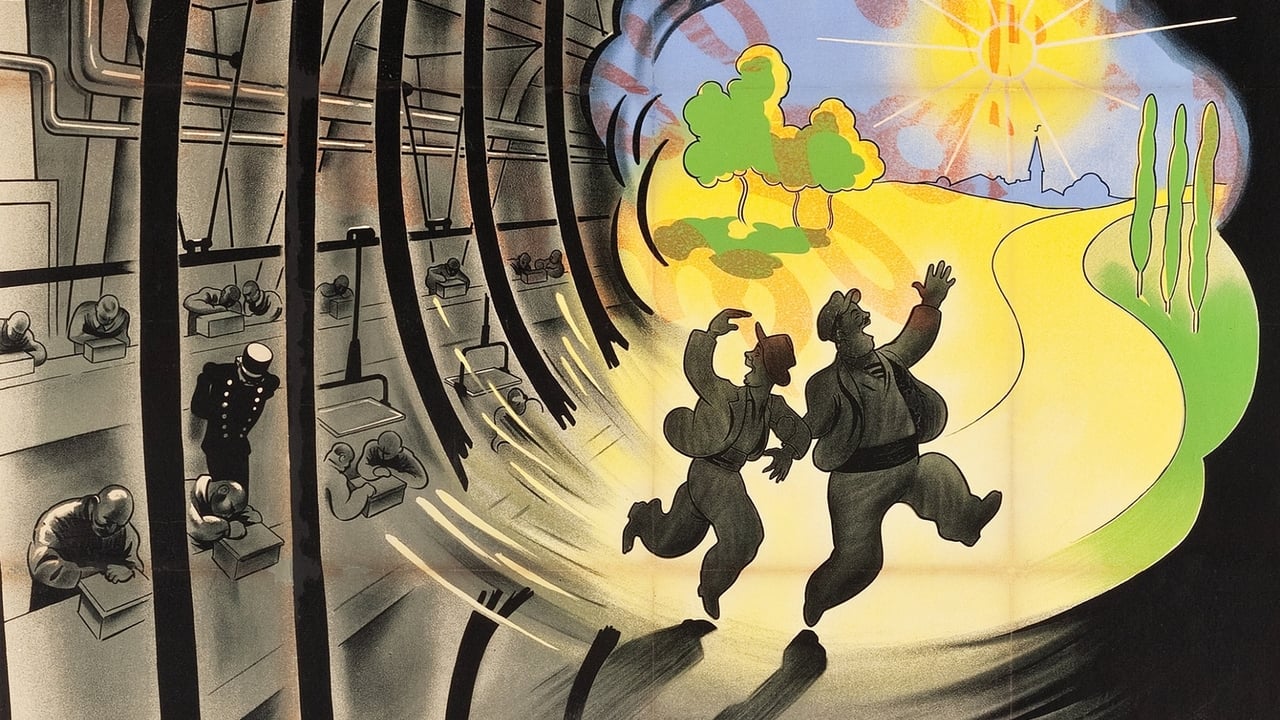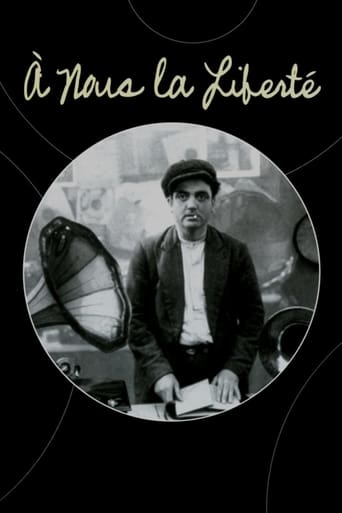

Raymond Cordi and Henri Marchand are two prisoners in an environment without soul. The inmates all sit at a long table and make tiny toy horses on an assembly line. When chow time rolls around they clunk along in ragged lockstep in their wooden sabots to the mess hall where they sit at long tables and serve themselves from a treadmill bearing bowls of food and pitchers of water.Cordi escapes with the help of Marchand who is captured. Cordi is a promoter and begins a business selling old phonograph records on the street. Soon he's a big shot, a millionaire in charge of a huge plant, and owner of The Record Palace.Later, Marchand escapes too, in the kind of scene that Charlie Chaplin might easily have used in "Modern Times", which appeared five years later. Marchard is in his cell and decides to hang himself. He fastens a short noose around his neck and ties the other end to the bars across his cell window. Then he jumps from the bed. His weight pulls the bars from the window and they fall with a clank on his head.Overjoyed, Marchand climbs to the open window and looks out. On the curb below him sits an armless and crippled beggar with a coat draped over him, cadging change from passers by. Marchand leaps from the window and lands atop the beggar, who jumps to his feet and shrugs off the coat, revealing two brawny arms. A mélée ensues and Marchand is able to dash away.I don't know if Chaplin was inspired by "À Nous la Liberté," but it's a little too coincidental that in both films the workers should sit at an assembly line, one should miss a beat, causing the next to miss a beat, and wind up with half a dozen workers piling all over one another trying to catch up to the unfinished items on the assembly line. I guess if it was good enough for René Clair it's good enough for Chaplin, and for Lucy and Ethel too, for that matter.The plot gets a bit complicated. Marchand seeks out Cordi, who is of two minds about the matter, but helps him out anyway. Others discover Cordi's real identity and expose him. But just as the police are about to take him in hand, Cordi decides to get out from under and turn the factory over to the workers.If it was funny and sometimes touching before, the climax is hilarious. An ancient executive of the company is trying to read a famous poem in front of all the other executives and the workers. Gradually, a wind begins to blow, and then blows even stronger. From a hidden stash, a thousand franc note blows passed the executives in their tuxedos and high hats. A second note. The executives are getting antsy as the notes blow past their feet. They fidget and squirm, trying to remain dignified as befits their status, until one of them breaks ranks and makes a bee-line for a thousand-franc note. Then they all run madly after the money and so does everyone else. The listeners brawl, the wind blows away the stand, the band disappears, and the wizened old speaker finally finishes his poem, only to look up and find the entire courtyard empty.Cordi is the model of a phony rich guy who has married into society and now has a wife who loathes him and is having an affair with another mustachioed man whose hair seems made entirely of grease. Marchand couldn't be better as the simple-minded and impulsive child-like figure. And the director, René Clair, has done well by them. When the two escapees are together and faced by some common threat, they exchange glances and we can hear the rough cadence of those wooden clogs on the prison floor.
... View MoreTwo of the previous reviews have the names of the main characters reversed, another is reviewing the wrong movie, and lots of them can't spell. But anyway, the film is both elegant and funny, the characters make wonderful facial expressions, and even though the version I watched was a little scanty with the subtitles, it wasn't hard to understand what was happening. I think the characters are very appealing. They are not sentimentalized as some of Chaplin's characters are, but they are still very sympathetic. What surprised me the most was how modern the sets looked - very spare and elegant. I don't know if actual places in the 1930's ever looked like the President's home, and I suspect very few places anywhere ever did, alas.
... View MoreA nous la liberte (1931) ** (out of 4) I know this film is hailed as a masterpiece and I know Chaplin's Modern Times owes a lot to it but that doesn't mean the film worked for me. Clair's satirical look at factory workers and their owners who are willing to exchange them for machinery is suppose to be a comedy but I'm not sure which part of it is. Having now seen the film for myself, I can see why the original company went after Chaplin because there's no way in hell that this film didn't influence Chaplin and his masterpiece. However, to me it seems Chaplin saw a technically brilliant but soul less film and made a much better picture. Credit should be given to Clair because the technical look of this film is brilliant and the music score is top notch but that's about as far as my admiration goes. There wasn't a single time in this film where I laugh and I only cracked a smile a couple times. The film is clearly spoofing the factory workers yet I could never see any of the spoof Had you not told me this was a comedy then everything on screen comes off as drama because it doesn't seem to me that there was any attempt for laughs. Another problem I had was the dialogue, which was great but at the same time it kind of went against what was going on in the scenes. The movie is filmed in a silent manor and in my opinion it probably would have worked best as a silent movie. The spoken words because somewhat distracting from the technical side of things so it came off to me as Clair was either making a silent film and later decided to make it sound or the film is just uneven.
... View MoreThis film is feral, anarchic energy, imbued with Clair's keen intelligence and siphoned through crowd-pleasing Chaplin-y slapstick. I am constantly reminded of Jean Vigo's timeless "Conduit Zero" and "L'Atalante" as I guffaw to "A Nous La Liberte"- this one, through the course of a lean, sinewy 83 minutes, deconstructs the wholly arbitrary norms and myths that constitute our mechanized, capitalistic civilization before illustrating just how easily these protocol are upset and subverted. I have learned that Rene Clair had previously lent his hand to the surrealists in the silent era, and that does not surprise me in the least, for this film is, for all its cynical realism, is Surrealist in agenda, a thorough exploration of Liberty.The premise is simple- two convicts escape from prison and pursue vastly disparate avenues outside penitentiary walls. One becomes an unscrupulous opportunist and erects a financial empire, the (rather effete) other is more smitten with a flighty factory girl than money. By a dialectical process the two eventually renounce chimeras like wealth and marriage, opting for a life of Deleuze/Guattari-esquire nomadism, true freedom unrestrained by social expectation. Clair is rarely subtle with his jibes- the factory workers are represented as wholly expendable vessels of labor, weighed and assigned with serial numbers. Their lives are mechanized to the point of eating slop from a conveyor belt. The Paris that Clair evokes is not a romanticised, perfumed city of profusion and resplendence, but a graven concrete sarcophagus, populated with automatons of all varieties. The sole glimpses we get of organic flora are of wretched-looking daffodils, offered to an unappreciative object of affection. Most biting are Clair's sketches of the bourgeoisie, whose cultivated tastes revolve around rumor-mongering, rococo decor and totally maudlin and cloying music. Everywhere carnality peers deviously beneath the gaping crevices, seething and sizzling beneath the Victorian prudishness- look at the rakish dilettante who woos the tycoon's wife, and the virile factory worker who commands the secretary's amorous attentions.Through the course of the film, Clair's intent is in drawing parallels between life in the penitentiary with dehumanizing industrial life and stuffy bourgeois society, illuminating the worrying commonalities that all three share. The conclusive insight, then, is truly surrealist- man constructs his own prisons, circumscribing the possibilities of existence with norms that he then perpetuates with bad faith. When this epiphany strikes our phonograph magnate, he becomes privy to the sheer tentativeness of these stifling dogmas, and engages in a journey towards freedom, culminating in his renunciation of wealth and reputation.The latter half of the film is a STINGING lash against cant and cupidity, and the film reaches a summit in one of the most uproarious and singularly BRILLIANT sections in French film- a fierce gust of wind disrupts an octagenarian's garrulous, grandiloquent (and nauseatingly vacuous) speech, blowing away the elaborate ornamentation adorning the speaker's podium and scattering a profusion of overhead banknotes across the compound. The gathered industrialists resist temptation for a few moments before a madcap scramble for cash ensues, the bumbling old speechmaker struggling to recite his script in the resultant mania, the sole bastion of 'order' in this wild debacle. This is Clair's consummate statement- beneath the ostentation and contrived niceties, we can barely obscure our animalistic greed. The wind blows beneath surfaces and reveals mercenary ardor.A political film that you can show to your kids, as well as a consummate, meticulous masterpiece on par with any Keaton, Chaplin or Tati. Like those artists and Friedrich Nietzsche, Clair knows all about the subversive power of laughter. We must take his approach to life, to nurture the capacity to laugh at all the things we take so gravely, our environs and even ourselves. This is the wellspring of ecstasy and freedom in life. I wonder if Luis Bunuel was a fan...
... View More